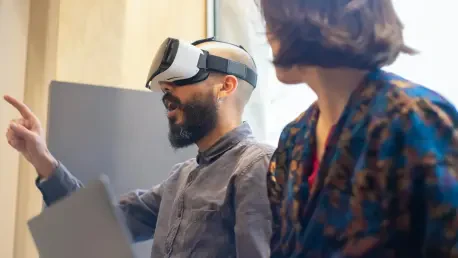Fixed version:
Imagine a world where digital assistants do more than just answer questions or schedule meetings—they look you in the eye, smile during a casual chat, or adopt a serious expression while tackling complex tasks. This is no longer a distant concept but a reality Microsoft is bringing to life with an innovative feature for its Copilot assistant. Announced recently, this development introduces dynamic digital avatars that transform the AI experience from a purely functional interaction into something far more personal and engaging. By giving a visual identity to an otherwise disembodied tool, Microsoft is taking a bold step toward making technology feel less like a machine and more like a companion. This shift not only enhances user engagement but also reflects a broader trend in the tech industry to humanize AI, bridging the gap between cold efficiency and relatable presence. As this feature rolls out on Windows, with plans to expand to web and mobile platforms soon, it’s clear that the way people interact with AI is poised for a significant evolution.
Redefining AI Interaction
The Power of Visual Connection
The introduction of dynamic avatars in Microsoft’s Copilot assistant marks a pivotal moment in how users perceive and engage with AI. Historically, interactions with digital assistants have been confined to text or voice, often feeling mechanical and detached. Now, with the integration of expressive avatars, there’s an added layer of visual communication that mimics human non-verbal cues. These avatars adapt their expressions based on the context of the conversation—showing curiosity when answering a question or encouragement during a brainstorming session. This subtle yet impactful change taps into the fundamental role facial expressions play in communication, making interactions feel more intuitive. For younger users familiar with avatars in gaming and social media, this feature could seem like a natural extension of their digital world, while for professionals, it softens the sterile nature of AI assistance, potentially fostering a deeper connection during daily tasks.
Beyond Functionality to Familiarity
This new visual dimension in Copilot isn’t just about aesthetics; it’s about building a sense of familiarity and trust with users. By presenting AI as a relatable entity rather than an abstract tool, Microsoft aims to make digital exchanges feel more like conversations with a colleague or friend. The avatars are designed to reflect the tone of the interaction, displaying a professional demeanor in business settings or a cheerful vibe during casual chats. This adaptability addresses a long-standing gap in AI communication—the absence of emotional resonance. Industry experts suggest that such personalization could significantly enhance user engagement, especially in environments like virtual meetings or educational platforms where a sense of presence matters. However, there’s a careful balance to strike, as over-humanizing AI risks blurring the line between machine and human, a concern that Microsoft appears to navigate by ensuring transparency that these are AI-generated representations.
The Future of Human-AI Collaboration
Technological Innovation Behind the Avatars
At the heart of this transformative feature lies cutting-edge generative image technology that powers the real-time adaptability of Copilot’s avatars. Unlike static images or emojis, these digital portraits dynamically adjust to the context and tone of interactions, reflecting emotions like studious focus or friendly reassurance as needed. Microsoft has prioritized user privacy in this design, relying on generic AI-generated visuals unless individuals choose to upload personal reference images for customization. Importantly, the company emphasizes that no personal likeness data is stored or reused, maintaining user control over how the avatar appears. This technological approach not only showcases the potential of generative AI in creating responsive interfaces but also sets a standard for ethical considerations in visual AI design, ensuring that personalization doesn’t come at the cost of privacy or security in an increasingly digital world.
Shaping Digital Presence Across Platforms
Looking ahead, the implications of this feature extend far beyond a single assistant, hinting at a broader transformation in digital presence across Microsoft’s ecosystem. Plans to introduce multiple personas—such as a study buddy for students or a productivity coach for professionals—suggest a future where AI adapts not just in expression but in identity to suit diverse user needs. This flexibility could redefine how AI integrates into virtual spaces like classrooms or corporate meetings, making it a more active participant rather than a background tool. Industry observers note that this trend might inspire other tech giants to explore similar visual enhancements, driving competition and innovation in AI design. As AI continues to inhabit more aspects of daily life, embedding a sense of identity and intent through avatars could become a cornerstone of user experience, fundamentally altering perceptions of technology as a partner rather than a utility.
Reflecting on a Milestone in AI Design
Reflecting on this development, it’s evident that Microsoft took a thoughtful step forward with the rollout of expressive avatars for its Copilot assistant. The initiative blended technological prowess with an understanding of human communication, creating a feature that added warmth to digital interactions. It stood as a testament to how small design changes, when executed with precision, could leave a lasting impact on user experience. By prioritizing privacy and adaptability, the company set a precedent for how AI could evolve into a more relatable presence. As the tech landscape looked back on this moment, it was clear that such innovations paved the way for deeper integration of AI into everyday life. Moving forward, the focus shifted to exploring how these avatars could further personalize experiences across diverse platforms while maintaining a clear distinction between human and machine. This balance remained crucial for fostering trust and ensuring that technology continued to serve as a supportive, rather than deceptive, companion in digital spaces.









